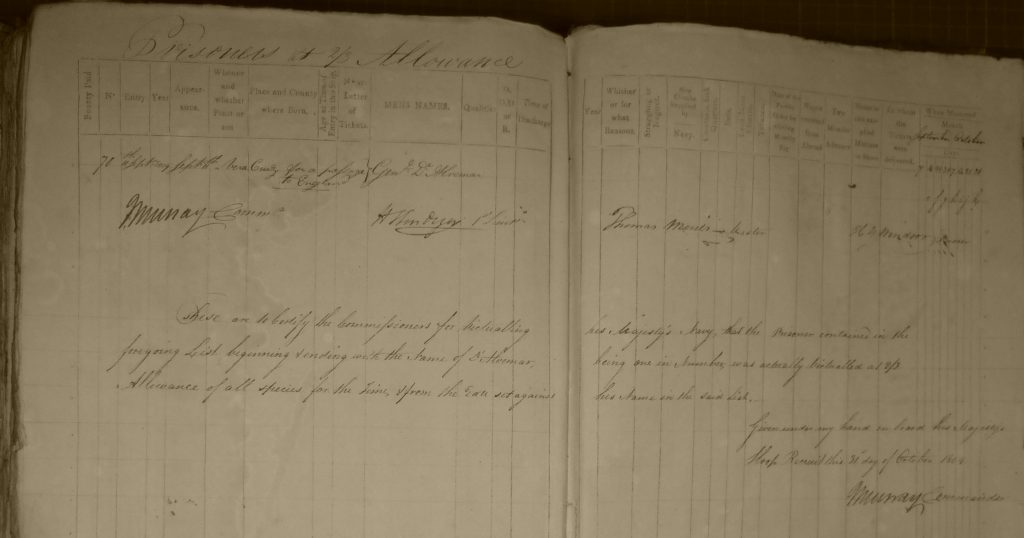While researching the Ceuta papers, we came across this letter from Captain McLeod of HMS Antelope1 which piqued our curiosity. Who was this ‘unpleasant ship-mate’?
Portsmouth 12th
D Sir
As I consider the Antelope entirely yours I beg to inform you that I have had a person put on board for a passage to Cadiz by the name of D’Alvimar who from the orders I have received with [ ] can only be considered as a State Prisoner. From his own account his fate varies hard and situation desparate & consequently an unplesant Ship-Mate for anybody and as he might be particularly so for 2 years [following?] I think it my Duty to acquaint you. He is to live with my Officers & as he seems a Gentleman & must be accommodated accordingly which will rather break in an [accr] soon.
[ ] you to consider that [action]. I think it proper to mention this to you to have no difficulty should the government wish him to go immediately.
I have the honor to be with greatest respect
Your Excellency’s
Most [ ]
National Archives ADM 1/2519
Written across the back of the letter is a note in another hand:
June 13
By which order was M. D’Alvimar put on board Antelope dispatched
Please see letter 28th Decr To Sir R. Curtis2
I [wish] to Sir Roger Curtis to say that I do declare M. D’Alvimar should not go on board the Antelope.
It turns out that Captain McLeod was wise to ring alarm bells about M. D’Alvimar as he was a man with a distinctly chequered history.
Gaetan Souchet D’Alvimart (or D’Alvimar) was born in 1770 and grew up around the court of Louis XVI where his father was in charge of the court pages. He later claimed to have been educated in military matters alongside the young Napoleon, a connection that he used throughout his life.
We pick up the story in 1809 when D’Alvimart was in New Spain as a self-appointed envoy from Napoleon, seeking to ensure that these territories remained loyal to Joseph Bonaparte, the newly-installed King of Spain, rather than to the Spanish Junta which still held sway in Cadiz and other parts of Spain.
His presence in the Americas had not gone down well and a Spanish consul in New Orleans described him as
…a man of talent, high enterprise, with no morality, cruel with an apparent and assumed affability, capable of insinuating himself into the hearts of the most imperturbable and of playing upon the ignorant at will.’
Gaetan Souchet D’Alvimart, The Alleged Envoy of Napoleon to Mexico, 1807–1809 – see note on sources below
Eventually he was arrested in Mexico and was due to be sent back to Spain but:
No Spanish captain was willing to transport this prisoner to Spain, because it was feared that, out of patriotism and anti-French feelings the crew might kill him during the voyage. The viceroy was therefore compelled to entrust him to the care of the English sailor, Andrew Cochrane, who had come to Mexico to help this colony resist an eventual French attack. In September, 1809, d’Alvimart was put on the British brigantine, the Recruit.
Gaetan Souchet D’Alvimart, The Alleged Envoy of Napoleon to Mexico, 1807–1809 – see note on sources below
His passage home on HMS Recruit is recorded in the Muster Rolls:

11 September Vera Cruz for a passage to England
These are to certify the Commissioners for Victualling, his Majesty’s Navy, that the prisoner contained in the foregoing list beginning and ending with the name of d’Alvimar, being one in number, was victualled at 2/3 the Allowance of all species, for the time, & from the date set against his name in the said list.
Murray – Commander
National Archives ADM 37/1719
On his return:
… D’Alvimart was taken prisoner to England, and spent a few months at a place that he called Odiham in his letters.3 He soon protested to the British government, and was finally shipped back to Cadiz on the frigate Sybil.4 The juntas then sent him to Ceuta in Spanish Morocco, where he was to remain more than ten years as a prisoner.
Gaetan Souchet D’Alvimart, The Alleged Envoy of Napoleon to Mexico, 1807–1809 – see note on sources below
McLeod’s letter no doubt dates from this period. D’Alvimart was not carried on the Antelope but on the smaller Sybille.
It was perceptive of Captain McLeod to sum up D’Alvimart so swiftly in his letter. Here was a man of ability and charm who, if the Spanish Consul is to be believed, was very full of himself and could not be trusted. He was not likely to have been a ‘pleasant ship-mate’ for McLeod’s officers.
Reading the main source, one is struck by the problems that D’Alvimart and others with royalist histories faced, trying to ingratiate themselves initially with the revolutionary regime(s), then with Napoleon, and finally with the restored monarchy. Difficult times indeed.
Sources
The main source is an article Gaetan Souchet D’Alvimart, The Alleged Envoy of Napoleon to Mexico, 1807–1809 by Jacques Houdaille, published online by Cambridge University Press: 11 December 2015.5 This is drawn on extensively by a Canadian author/researcher Shannon Selin.6
There were actually two brothers, Gaetan being the elder, and Octavien the younger. Although well-researched, the article quoted may confuse the two, not helped by Gaetan’s habit of pretending to be his brother as he sought advancement.
- A 50 gun third rate ship
- Admiral Sir Richard Curtis was CiC Portsmouth 1809-1810
- Odiham in Hampshire was a prison camp for Naval officers on parole
- Actually HMS Sybille
- This is behind a paywall
- https://shannonselin.com/2020/01/gaetan-octavien-dalvimart
